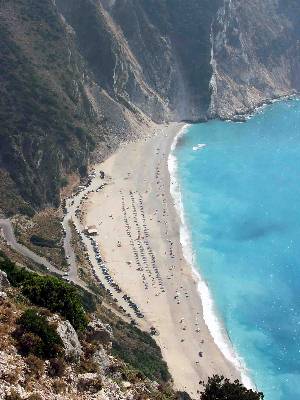 |
 |
 |
| Our first arrival to Greece in 2002 brought us to the islands of the Ionian Sea, but we didn't yet appreciate their lush greenery, postcard-perfect waters, or its many uncrowded nooks and crannies for anchoring and swimming during the hot days of summer. Here, Swept Away is anchored just under a lighthouse at the top of Zakynthos Island, and within dinghy distance from a personal exploration of the blue caves. | |
| The arches of the blue caves of Zakynthos were
carved out by the steady erosion of the sea. The sun-drenched water reflects
shades of turquoise and blue in the unending Mediterranean summer light.
Tour boats leave from nearby ports such as Agios Nikolaos, and the small boats duck under the arches and into the caves along the rock. Orange coral adds color to the underwater vista. |
|
| There are two legends associated with the underground
cave-lake on Kefallonia named Melissani. The first is that a shepherdess of
that name fell in and drowned while searching for a lost lamb. The second is
that the nymph Melissani drowned herself in the lake when the goatlike god
Pan did not return her love. According to that myth, dolphins (now petrified
as dolphin-shaped stalactites in the cave) acted as couriers, delivering her
futile entreaties to the lusty god.
The maximum depth of the lake is 36 meters (more than 100 feet) and the water's composition can only support a few varieties of sea life. Part of the ceiling collapsed into the lake, which provides pockets of bright light like spotlights on the water. |
|
| The entrance to Drogarati Cave was created about 300 years ago by an earthquake, though the cave itself represents tens or hundreds of millions of years of creation. It takes a thousand years for one centimeter of stalactite to form. The cave is 60 meters (almost 200 feet) below the ground. Though it was bone dry outdoors, and had been for months, ground water dripped relentlessly from the ceiling. The air is so cool and the acoustics inside the cave are so fine that summer concerts are performed there. | |
 |
Myrtos Beach, also on Kefallonia, is among the most
beautiful natural places we've seen since we've traveled in the
Mediterranean. Steep cliffs mark the inland edge of a sandy, then pebbly,
beach, and iridescent turquoise water marks the shoreline. Even the Blue
Flag organization, which awards a coveted designation to only the cleanest
beaches, mentions on its web site that Myrtos has been called the "best
beach in Greece."
This island, devastated in a 1953 earthquake, was the inspiration for the novel "Captain Corelli's Mandolin" and the filming location for the movie. |